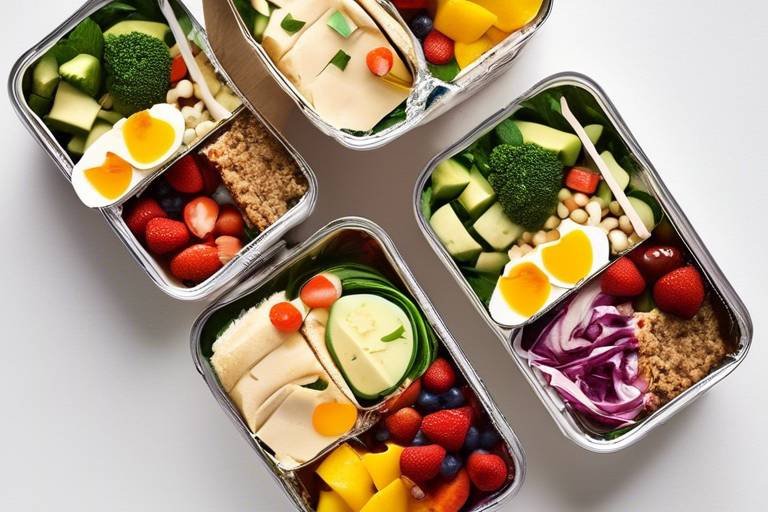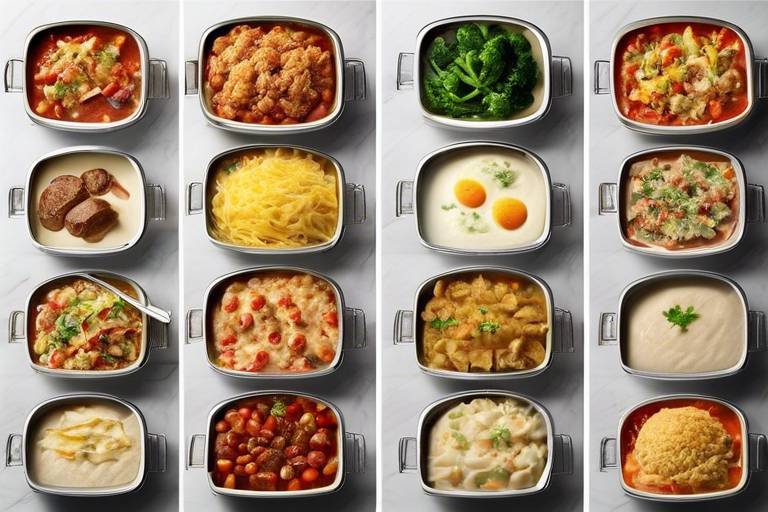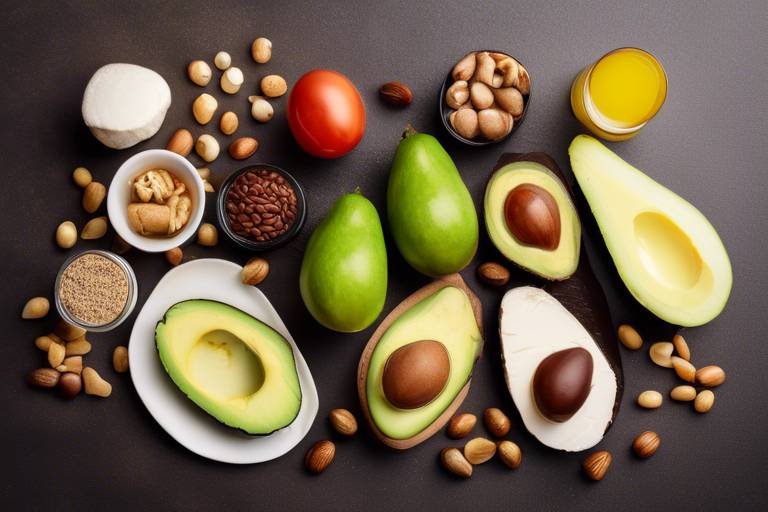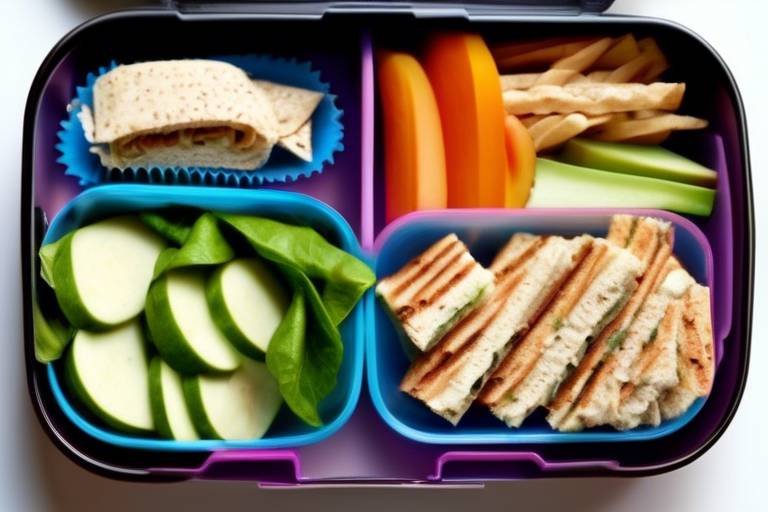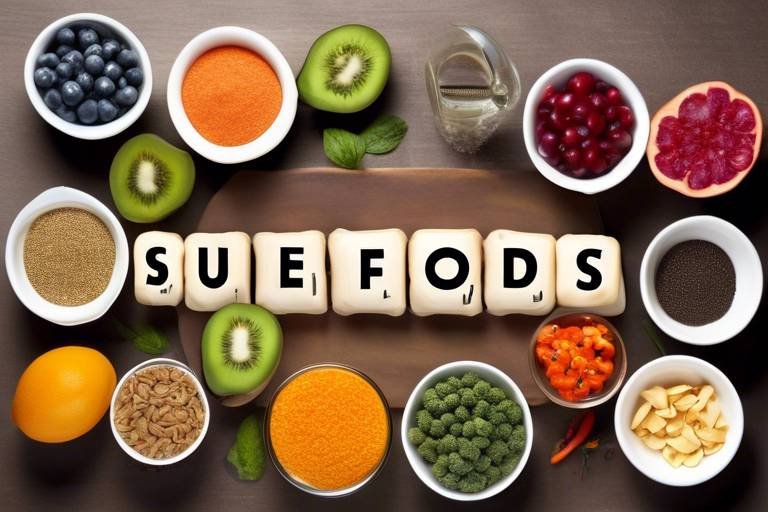Easy Meal Planning Strategies for Large Families
Meal planning can feel like a daunting task, especially when you’re catering to a large family. The hustle and bustle of daily life can make it seem impossible to whip up nutritious meals without spending hours in the kitchen. However, with some effective strategies, you can streamline your cooking process, save time, and reduce stress. Imagine walking into your kitchen with a clear plan, knowing exactly what to cook and how to make it in a fraction of the time. Sounds ideal, right? Let’s dive into some easy meal planning strategies that will not only satisfy everyone’s taste buds but also make your life a whole lot easier!
The first step in successful meal planning is understanding the unique dietary needs and preferences of your family members. Each person may have different tastes, allergies, or nutritional requirements. Start by having a family meeting where everyone can share their favorite meals and any dietary restrictions they might have. This way, you can create a meal plan that is both nutritious and enjoyable for everyone. Consider using a simple table to help you organize this information:
| Family Member | Favorite Foods | Allergies | Dietary Preferences |
|---|---|---|---|
| Mom | Pasta, Salad | Nuts | Vegetarian |
| Dad | Steak, Potatoes | None | Meat Lover |
| Child 1 | Pizza, Chicken | Dairy | None |
| Child 2 | Fish, Rice | None | Gluten-Free |
This table can serve as a reference point, helping you to craft a meal plan that caters to everyone’s needs. Remember, the more you know about what your family enjoys and requires, the easier it will be to create a tailored meal plan that keeps everyone happy and healthy.
Once you have a clear understanding of your family’s needs, it’s time to create a weekly menu. A well-structured menu not only simplifies grocery shopping but also makes meal prep a breeze. Start by brainstorming meals for the week that include a variety of proteins, vegetables, and grains. Aim for a balance that incorporates different food groups, ensuring that everyone gets a well-rounded diet.
Here’s a simple example of how you might structure your weekly menu:
- Monday: Grilled Chicken with Quinoa and Steamed Broccoli
- Tuesday: Tacos with Ground Turkey, Lettuce, and Tomatoes
- Wednesday: Pasta Primavera with Seasonal Vegetables
- Thursday: Baked Salmon with Sweet Potatoes and Asparagus
- Friday: Pizza Night with Homemade Dough and Toppings
- Saturday: Stir-Fried Tofu with Mixed Vegetables
- Sunday: Family BBQ with Grilled Veggies and Meats
This menu not only provides variety but also ensures that you’re using seasonal ingredients, which can enhance flavor and nutrition. Plus, having a plan in place means you can shop efficiently, reducing the time spent wandering the aisles.
One of the best ways to save time and minimize waste is by effectively utilizing leftovers. Instead of letting food go to waste, think creatively about how to repurpose it into new meals. For example, if you have leftover grilled chicken, consider using it in a salad, sandwich, or stir-fry the next day. This not only saves you cooking time but also keeps meals exciting and varied.
Batch cooking is another fantastic strategy for large families. By preparing larger quantities of meals in advance, you can save time during the week. Dedicate a few hours on the weekend to cook staples like rice, beans, or roasted vegetables. Store them in the fridge or freezer, and you’ll have them ready to go for quick meals throughout the week. Imagine coming home after a long day and simply reheating a delicious, homemade meal!
Speaking of the freezer, some recipes are perfect for freezing. Think about dishes like soups, stews, or casseroles that can be made in bulk and stored for later. Here are a few freezer-friendly recipes to consider:
- Vegetable Lasagna
- Chicken and Rice Casserole
- Chili
- Beef Stew
These meals not only save time but also ensure that you always have a delicious option ready to go when you need it.
Effective grocery shopping is crucial for successful meal planning. Start by creating a shopping list based on your weekly menu. This will help you avoid impulse buys and ensure you have everything you need. Consider budgeting as well; knowing how much you want to spend can help you make smarter choices while shopping.
Coupons and discounts can significantly reduce your grocery bills. Take some time to look for deals online or in local newspapers before heading to the store. Many grocery stores also have loyalty programs that can help you save even more money. By being strategic about your shopping, you can keep your budget in check while still providing healthy meals for your family.
Incorporating seasonal ingredients into your meal planning not only enhances flavor but can also be more affordable. Seasonal produce is often fresher and more nutrient-dense, making it a win-win for your family’s health and your budget. Visit local farmers' markets or check your grocery store for seasonal specials to make the most of what’s available.
Finally, it’s important to stay flexible with your meal planning. Life can be unpredictable, and sometimes plans change. Be prepared to adjust your menu as needed without feeling stressed. If a family member has a last-minute craving or an unexpected event comes up, don’t hesitate to swap meals around. The key is to maintain a positive attitude and remember that meal planning is meant to make your life easier, not more complicated.
Q: How can I get my kids involved in meal planning?
A: Involve your kids by letting them choose a meal each week or help with simple cooking tasks. This encourages them to try new foods and makes mealtime more fun!
Q: What should I do with leftover ingredients?
A: Get creative! Use leftover ingredients in salads, soups, or stir-fries. You can also freeze them for later use.
Q: How can I make meal prep quicker?
A: Consider batch cooking and prepping ingredients in advance. Having pre-chopped veggies or cooked proteins on hand can save you a lot of time during the week.

Understanding Family Needs
When it comes to meal planning for large families, understanding the unique dietary preferences and nutritional needs of each family member is absolutely crucial. After all, every family is a melting pot of tastes, allergies, and health goals. Have you ever tried to satisfy a picky eater while also catering to someone who’s on a health kick? It can feel like trying to solve a Rubik’s Cube blindfolded! That’s why taking the time to assess these needs will not only help in creating a tailored meal plan but also foster a sense of inclusivity and satisfaction at the dinner table.
Start by having a family meeting—yes, you heard that right! Gather everyone around and discuss their favorite foods, any dietary restrictions, and what they absolutely can’t stand. This is a golden opportunity to turn meal planning into a fun family activity. You might be surprised at what you learn! For example, one child may love broccoli while another can't stand it. By understanding these preferences, you can create meals that everyone will enjoy, reducing the chances of food waste and complaints.
It’s also essential to consider the nutritional needs of each family member. Are you feeding growing teenagers who seem to have an insatiable appetite? Or are you trying to accommodate an older family member with specific dietary restrictions? Here’s a quick breakdown of common dietary considerations:
| Family Member | Dietary Needs |
|---|---|
| Children | High energy foods, calcium, and iron-rich options |
| Teenagers | Protein-rich meals for growth and development |
| Adults | Balanced meals with a focus on whole foods |
| Seniors | Low-sodium, low-sugar options, and fiber-rich foods |
By keeping these needs in mind, you can create a meal plan that is not only diverse but also caters to the health and happiness of your entire family. And don’t forget to check in periodically! As kids grow and tastes change, so should your meal planning. This adaptability will keep mealtime exciting and ensure that everyone feels heard and valued.
In conclusion, understanding family needs is the bedrock of effective meal planning. It’s all about creating a balance between what everyone loves and what’s good for them. So, roll up your sleeves, get the family involved, and start crafting meals that will make everyone feel like they belong at the table!

Creating a Weekly Menu
Creating a weekly menu is like crafting a roadmap for your culinary journey, especially when you’re navigating the bustling life of a large family. It not only helps in organizing your meals but also ensures that you’re serving up a variety of nutritious options that cater to everyone’s tastes. Think of it as a puzzle where each piece fits perfectly into the bigger picture of your week. Start by assessing what each family member enjoys and any dietary restrictions they may have. This will guide you in selecting meals that everyone will look forward to, rather than dread!
To kick off your weekly menu, consider sitting down with your family for a fun brainstorming session. You might be surprised at how many ideas come pouring out when everyone has a say. This collaborative approach not only makes meal planning more enjoyable but also encourages kids to try new foods when they feel included in the process. Once you have a list of potential meals, aim for a balanced mix of proteins, vegetables, and grains. A good rule of thumb is to include:
- 2-3 protein sources (like chicken, beans, or fish)
- 4-5 different vegetables (think color and variety!)
- 2-3 whole grains (such as quinoa, brown rice, or whole grain pasta)
Next, you can create a simple table to visualize your weekly menu. Here’s an example layout:
| Day | Breakfast | Lunch | Dinner |
|---|---|---|---|
| Monday | Pancakes with fruit | Tuna salad | Grilled chicken with vegetables |
| Tuesday | Oatmeal with nuts | Turkey wraps | Pasta Primavera |
| Wednesday | Smoothies | Quinoa salad | Beef stir-fry |
| Thursday | Eggs and toast | Chicken Caesar salad | Fish tacos |
| Friday | Yogurt and granola | Vegetable soup | Pizza night! |
| Saturday | French toast | Leftover buffet | BBQ night |
| Sunday | Bagels with cream cheese | Sandwiches | Roast dinner |
Once your menu is set, don’t forget to create a shopping list based on the ingredients you’ll need for each meal. This will save you time and prevent those last-minute grocery runs that can disrupt your week. Remember, the goal is to keep it simple and flexible. If something comes up or a family member suddenly craves a different dish, feel free to swap meals around. After all, cooking should be a joyful experience, not a chore!
Incorporating a weekly menu into your routine can significantly reduce stress in the kitchen. It allows you to plan ahead, minimizes the dreaded “What’s for dinner?” question, and helps you make healthier choices. Plus, it opens up the opportunity to explore new recipes and flavors together as a family. So grab that pen and paper, or your favorite meal planning app, and start crafting your delicious weekly menu!

Incorporating Leftovers
Leftovers can be a game-changer for large families, transforming what could be a daunting task into a delightful culinary adventure. Instead of viewing leftovers as mere remnants of past meals, think of them as the building blocks for new, exciting dishes. By creatively repurposing what you already have, you not only minimize waste but also save precious time in the kitchen. Have you ever considered how a simple roast chicken can evolve into a delicious chicken salad or a hearty soup? The possibilities are endless!
To effectively incorporate leftovers into your meal planning, start by categorizing them. You can create a simple chart to track what you have on hand. For example, if you roasted a large turkey, you might have:
| Leftover Item | Possible Repurposed Dishes |
|---|---|
| Roasted Chicken | Chicken Salad, Chicken Tacos, Chicken Soup |
| Steamed Vegetables | Vegetable Stir-fry, Vegetable Frittata, Vegetable Soup |
| Cooked Rice | Fried Rice, Rice Pudding, Stuffed Peppers |
By keeping a record of your leftovers and their potential transformations, you can easily plan your meals for the week. Additionally, consider involving your family in this process. Ask everyone for their input on what they’d like to see made from the leftovers. This not only fosters a sense of teamwork but also ensures that everyone is excited about the meals ahead.
Another effective strategy is to designate specific days for leftover meals. For instance, you could implement “Leftover Fridays” where the family enjoys a buffet-style dinner featuring a variety of repurposed dishes. This not only adds a fun twist to the week but also reduces food waste significantly. Remember, leftovers don’t have to be boring; with a little creativity, they can be the highlight of your meal planning!
In conclusion, incorporating leftovers into your meal planning is not just practical; it’s a smart way to enhance your family’s dining experience. By embracing the challenge of transforming yesterday’s meals into today’s culinary delights, you’ll find that meal prep becomes less of a chore and more of an enjoyable family activity. So, the next time you find yourself staring at a fridge full of leftovers, don’t panic—get creative!
- How long can I keep leftovers in the fridge? Generally, leftovers can be safely stored in the fridge for 3 to 4 days. Be sure to label them with the date they were made to keep track.
- Can I freeze leftovers? Yes! Most leftovers freeze well. Just make sure to store them in airtight containers to prevent freezer burn.
- What are some easy ways to use up leftovers? Consider making casseroles, soups, or stir-fries. You can also add them to salads or wraps for a quick meal!

Batch Cooking Techniques
Batch cooking is like having a secret weapon in your culinary arsenal, especially when you're feeding a large family. Imagine this: instead of scrambling every evening to whip up dinner, you can spend a few hours on the weekend prepping meals that will last you through the week. It’s all about efficiency and organization, allowing you to enjoy more family time and less kitchen chaos.
To get started with batch cooking, first, choose a day when you can dedicate a few hours to meal prep. This could be a Saturday or Sunday morning when the family is still lounging around. Begin by selecting recipes that are not only family favorites but also those that can be easily scaled up. Think about dishes like soups, stews, casseroles, and even pasta sauces. These meals tend to freeze well and can be reheated without losing their deliciousness.
Next, gather your ingredients. Having everything on hand before you start will make the process smoother. You might want to create a shopping list to ensure you don’t forget anything. Once you have your ingredients, it’s time to get cooking. You could set up multiple pots and pans on the stove, or even use your oven to cook several dishes simultaneously. This multitasking will save you a ton of time!
After cooking, it’s essential to store your meals properly. Invest in high-quality, airtight containers that are freezer-safe. Label each container with the name of the dish and the date it was made. This way, you can easily keep track of what you have and ensure you use the oldest meals first. Here’s a quick table to help you understand the best ways to store different types of meals:
| Meal Type | Storage Method | Freezer Life |
|---|---|---|
| Soups & Stews | Airtight containers or freezer bags | 3-6 months |
| Casseroles | Aluminum foil or glass containers | 2-3 months |
| Pasta Dishes | Freezer-safe plastic containers | 2-3 months |
| Cooked Proteins | Freezer bags or containers | 4-6 months |
Finally, don’t forget about repurposing your meals. For instance, if you make a large batch of chicken, you can use it in tacos one night and in a salad the next. This not only keeps things interesting but also ensures that nothing goes to waste.
Batch cooking is more than just a trend; it’s a lifestyle change that can save you time and stress. So gather your family, pick a day, and get cooking! Your future self will thank you for the delicious, home-cooked meals waiting in the freezer, ready to be enjoyed.
1. How long can I store batch-cooked meals in the freezer?
Most meals can be stored in the freezer for 2-6 months, depending on the type of dish. Always label your containers with dates!
2. Can I batch cook for special diets?
Absolutely! Just make sure to choose recipes that fit your family’s dietary needs, whether that’s gluten-free, vegetarian, or low-carb.
3. What’s the best way to reheat frozen meals?
The best way to reheat is to thaw in the refrigerator overnight and then warm in the oven or on the stove. You can also microwave them, but be sure to stir occasionally for even heating.
4. Is batch cooking cost-effective?
Yes! Buying ingredients in bulk and cooking in larger quantities can significantly reduce your grocery bills and minimize food waste.

Freezer-Friendly Recipes
When it comes to meal planning for large families, are nothing short of a lifesaver. Imagine coming home after a long day, and instead of scrambling to whip up dinner, you simply reach into your freezer and pull out a delicious, homemade meal. Sounds dreamy, right? The beauty of freezer-friendly recipes is that they not only save you time but also help in reducing food waste while ensuring your family eats nutritious meals. Let's dive into some fantastic options!
One of the most popular freezer-friendly meals is chili. This hearty dish is packed with protein and fiber, making it a filling option for your family. You can make a big batch over the weekend, portion it out into containers, and freeze. When you're ready to eat, just thaw it overnight in the fridge and reheat it on the stove or in the microwave. You can also get creative with variations, such as adding different beans, veggies, or spices to keep things interesting.
Another fantastic option is lasagna. Not only is it a crowd-pleaser, but it also freezes exceptionally well. You can prepare your lasagna in a disposable aluminum pan, cover it tightly with foil, and freeze it before baking. When you want to serve it, just pop it straight into the oven from the freezer, adding a bit more time to the baking process. The result? A cheesy, comforting meal that feels like a warm hug!
For those busy weeknights when you need something quick, consider making frozen smoothie packs. Just combine your favorite fruits, greens, and a scoop of protein powder in a freezer bag. When you’re ready for a smoothie, dump the contents into your blender, add your choice of liquid (like almond milk or yogurt), and blend away. It's a nutritious breakfast or snack that takes mere minutes to prepare!
Soups are also an excellent choice for freezing. Whether it’s a creamy tomato basil or a chunky vegetable soup, most soups freeze beautifully. When storing, make sure to leave some space in the container, as liquids expand when frozen. You can even create a soups of the month plan, making a different soup each week and freezing it for later use. This not only diversifies your freezer meals but also gives your family a variety of flavors to enjoy.
Lastly, don’t forget about casseroles. These one-dish wonders can be loaded with all sorts of ingredients, from chicken and rice to veggies and cheese. Prepare your casserole, cover it tightly, and freeze before baking. When it's time for dinner, you can bake it straight from the freezer or thaw it first for a quicker bake time. The best part? You can customize them to fit your family's tastes, making sure everyone is satisfied.
In conclusion, incorporating freezer-friendly recipes into your meal planning can be a game-changer for large families. Not only do they save time and effort, but they also ensure that you always have a nutritious meal ready to go. So, stock up that freezer and enjoy the convenience of homemade meals at your fingertips!
1. How long can I keep meals in the freezer?
Most meals can be stored in the freezer for up to three months. However, for the best taste and texture, it's ideal to consume them within one month.
2. Can I freeze all types of food?
While many foods freeze well, some items like fresh vegetables may lose their texture. It's best to blanch vegetables before freezing them for optimal results.
3. How do I properly thaw frozen meals?
The safest way to thaw frozen meals is in the refrigerator overnight. You can also use the microwave for quick thawing, but be sure to cook the food immediately after.
4. Are there any specific containers I should use for freezing?
Use airtight containers or freezer bags designed for freezing to prevent freezer burn. Make sure to label and date your meals for easy identification.

Involving Family Members
When it comes to meal planning for large families, one of the most effective strategies is to involve everyone in the process. Think about it: cooking for a big family can sometimes feel like a daunting task, but when you turn it into a family affair, it not only lightens the load but also adds a sprinkle of fun to the kitchen chaos. So, how can you get everyone on board? Start by having a family meeting where you can discuss everyone's favorite meals and dietary preferences. This way, everyone feels heard and valued, and you can create a meal plan that caters to a variety of tastes.
Encourage your family members to take on specific roles in the meal preparation process. For instance, assign tasks based on age and skill level. Younger children can help with washing vegetables or setting the table, while older kids can take charge of chopping ingredients or even cooking simple dishes. This not only teaches them valuable life skills but also fosters a sense of responsibility. Plus, when they contribute to the meal, they are more likely to eat what’s on their plates!
Another great idea is to have a weekly cooking night where the family comes together to prepare meals for the week. You can make it a themed night, like Taco Tuesday or Pizza Night, where everyone can customize their own toppings. This collaboration not only makes meal prep more enjoyable but also creates lasting memories. Don't forget to capture these moments with photos; they’ll be fun to look back on!
To make things even more engaging, consider implementing a family recipe book. Each family member can contribute their favorite recipes, and you can compile them into a book that everyone can use. This not only preserves family traditions but also gives everyone a sense of ownership over the meals you prepare together. You might even discover hidden culinary talents among your kids!
Lastly, remember to celebrate your successes. After a week of meal planning and cooking together, take a moment to reflect on what went well and what could be improved. This open dialogue can help everyone feel more involved and invested in the process. Plus, it sets the stage for continuous improvement and adaptation, making meal planning a dynamic and enjoyable experience for your family.
Q: How can I get my kids interested in cooking?
A: Start by letting them choose a meal they want to cook. Involving them in the decision-making process can spark their interest. Also, make cooking fun by playing music or turning it into a game!
Q: What if my family has different dietary restrictions?
A: Create a flexible meal plan that includes a variety of options. You can prepare base meals, like grilled chicken or roasted vegetables, and allow family members to customize their plates with different toppings or sides.
Q: How do I manage time effectively while cooking with my family?
A: Plan ahead by prepping ingredients beforehand. You can also assign tasks to each family member to ensure everything gets done in a timely manner. Setting a timer for each task can also help keep everyone focused.

Shopping Smart
When it comes to feeding a large family, effective grocery shopping is the backbone of successful meal planning. It's not just about filling your cart; it's about making strategic choices that save you time, money, and stress in the long run. So, how do you shop smart? Well, it starts with creating a comprehensive shopping list. This list should be based on your weekly menu, which we discussed earlier. By having a clear idea of what you need, you can avoid those impulse buys that can quickly add up. Plus, shopping with a list keeps you focused and efficient.
Next, consider your budget. It’s essential to set a realistic grocery budget that accommodates your family's needs without breaking the bank. To do this effectively, track your spending for a month to see where your money goes. You might be surprised by how much those little extras can add up! Once you have a clear picture, allocate funds for different categories like produce, proteins, and pantry staples. This way, you can prioritize what’s most important to your family.
Another smart shopping tip is to choose the right stores. Not all grocery stores are created equal, and each may offer different deals or products. For instance, consider visiting local farmers' markets for fresh, seasonal produce, which can often be cheaper than supermarket prices. Additionally, big-box stores may offer bulk items at a discount, which is perfect for large families. It’s all about finding the right balance between quality and cost.
As you navigate the aisles, keep an eye out for coupons and discounts. Using coupons can significantly reduce your grocery bills, especially when combined with sales. Many stores have loyalty programs that offer exclusive discounts or points that can be redeemed later. To maximize your savings, consider the following:
- Sign up for store newsletters to receive digital coupons.
- Use coupon apps that aggregate deals from various stores.
- Plan your meals around the weekly sales to take advantage of discounts.
Lastly, don’t forget the power of seasonal ingredients. Shopping for seasonal produce not only supports local farmers but also ensures that you’re getting the freshest ingredients at a lower price. Seasonal fruits and vegetables often taste better and provide higher nutritional value. For example, in the summer, you can find delicious tomatoes and zucchini, while winter brings hearty root vegetables like carrots and potatoes. Incorporating these into your meal planning can enhance flavor and variety in your family's meals.
In summary, smart shopping is about being organized, budget-conscious, and adaptable. By creating a thorough shopping list, sticking to your budget, choosing the right stores, utilizing coupons, and opting for seasonal ingredients, you’ll set your family up for success in the kitchen. Remember, the goal is not just to feed your family, but to nourish them with delicious, healthy meals that everyone can enjoy together.
Q: How can I save money on groceries for my large family?
A: Start by creating a detailed shopping list based on your meal plan, stick to your budget, and look for coupons and discounts. Shopping for seasonal ingredients can also help reduce costs.
Q: What are some tips for efficient grocery shopping?
A: Plan your shopping trips around store sales, use a grocery list to avoid impulse buys, and consider bulk purchases for items your family uses frequently.
Q: How can I involve my family in the shopping process?
A: Make grocery shopping a family outing! Assign each family member a section of the store to gather items or let them help in creating the shopping list based on their preferences.

Utilizing Coupons and Discounts
When it comes to managing a large family's grocery budget, coupons and discounts can be your best friends. Imagine walking into a store with a strategy that not only fills your cart but also keeps your wallet happy. Sounds great, right? But how do you go about finding and using these money-saving tools effectively? Let’s dive into some practical tips that can help you maximize your savings.
First off, start by researching local stores and their coupon policies. Many grocery stores offer weekly ads that highlight discounts on popular items. You can usually find these ads in your mailbox, local newspapers, or on the store's website. Some stores even have apps that provide exclusive digital coupons. By keeping an eye on these promotions, you can plan your meals around what's on sale, ensuring you get the most bang for your buck.
Another fantastic way to save is by utilizing coupon clipping services. Websites and apps like Coupons.com or Rakuten allow you to browse a wide variety of coupons tailored to your favorite brands and products. You can print them out or use them directly from your smartphone at checkout. If you have a favorite product that your family loves, make it a habit to search for coupons regularly. You might be surprised at how much you can save over time!
Don't forget to check out store loyalty programs. Many grocery chains offer rewards cards that not only give you access to exclusive discounts but also allow you to earn points for future purchases. For large families, these points can add up quickly, translating to significant savings on your next grocery run. Plus, some programs even offer personalized coupons based on your shopping habits. It’s like having a personal shopper that knows exactly what your family needs!
While using coupons is a great way to save, it's also essential to keep an eye on expiration dates. Nothing is more disappointing than reaching the checkout only to find that your carefully clipped coupon is no longer valid. To avoid this, consider creating a coupon binder or an envelope system where you can organize your coupons by category, expiration date, or store. This way, you can easily access them while shopping, ensuring you never miss out on a deal.
Lastly, one of the most effective strategies is to combine coupons with sales. If you know an item is going on sale next week, hold off on buying it until then. Use your coupon during the sale to maximize your savings. For example, if a box of cereal is regularly priced at $5 but is on sale for $3, and you have a $1 coupon, you’ll end up paying just $2 for it! This kind of planning can make a huge difference in your overall grocery budget.
By incorporating these strategies into your shopping routine, you can effectively reduce your grocery expenses while still providing your family with the meals they love. It’s all about being proactive and organized. So, grab those scissors, download those apps, and get ready to save!
- How can I find the best coupons? Check local newspapers, store websites, and coupon apps for the latest deals.
- Are digital coupons better than paper ones? Digital coupons are often easier to use and can be accessed on the go, making them a convenient choice.
- Can I use multiple coupons on one item? It depends on the store's policy, but many allow stacking manufacturer and store coupons for extra savings.
- What should I do if I forget to use a coupon? Some stores may allow you to return for a refund if you have your receipt and the coupon.

Choosing Seasonal Ingredients
When it comes to meal planning, one of the simplest yet most effective strategies is to focus on seasonal ingredients. But why is this so important? Well, seasonal produce is not only fresher but also tends to be more affordable and flavorful. Think about it: when fruits and vegetables are in season, they are harvested at their peak ripeness, which means they're bursting with flavor and nutrients. This is a win-win for your family’s health and your taste buds!
Imagine biting into a juicy, sun-ripened tomato in the summer or a crisp, sweet apple in the fall. These seasonal delights can elevate your meals from ordinary to extraordinary. Plus, they often cost less than out-of-season produce, which has to be shipped from far away. By choosing local and seasonal ingredients, you’re not only saving money but also supporting local farmers and reducing your carbon footprint. It’s like giving a high-five to Mother Nature!
So, how can you incorporate seasonal ingredients into your meal planning? Start by researching what’s in season in your area. Many websites and local farmers' markets provide lists of seasonal produce, making it easier for you to shop smart. For instance, in the spring, you might find vibrant asparagus and sweet strawberries, while autumn brings hearty squash and crunchy pears. Here’s a quick guide to some seasonal favorites:
| Season | Fruits | Vegetables |
|---|---|---|
| Spring | Strawberries, Cherries | Asparagus, Spinach |
| Summer | Peaches, Watermelon | Tomatoes, Zucchini |
| Fall | Apples, Pears | Squash, Brussels Sprouts |
| Winter | Citrus Fruits, Pomegranates | Root Vegetables, Kale |
With this table in hand, you can easily plan your meals around what's available. Not only does this approach make your shopping trips easier, but it also encourages you and your family to try new recipes and flavors. Have you ever roasted seasonal vegetables tossed in olive oil and herbs? The taste is simply out of this world!
Moreover, incorporating seasonal ingredients can lead to a more sustainable lifestyle. Eating what's in season reduces the demand for out-of-season produce, which often involves energy-intensive farming practices and long-distance transportation. Choosing to go seasonal is like giving the planet a big hug!
In conclusion, embracing seasonal ingredients in your meal planning not only enhances the flavor and nutrition of your meals but also supports local agriculture and promotes sustainability. So, next time you’re drafting your grocery list, take a moment to consider what’s in season. Your taste buds, your wallet, and the environment will thank you!
- What are the benefits of eating seasonal ingredients? Eating seasonal ingredients ensures that you get the freshest produce, which is often more flavorful and nutrient-rich. It can also save you money and support local farmers.
- How can I find out what’s in season? You can check local farmers' markets, agricultural extension offices, or online resources that list seasonal produce specific to your region.
- Can I still eat out-of-season produce? While it’s okay to enjoy out-of-season produce occasionally, focusing on seasonal items can enhance your meals and save you money.

Staying Flexible
When it comes to meal planning for large families, flexibility is not just a bonus; it's a necessity. Life is unpredictable, and the best-laid plans can often go awry. Whether it's a last-minute invitation to a friend's barbecue or a child coming down with a cold, being able to adapt your meal plan can save you a lot of stress. Imagine this: you’ve spent hours crafting the perfect menu for the week, only to find out that your plans have changed. Instead of feeling overwhelmed, having a flexible approach allows you to pivot without losing your sanity.
One effective way to incorporate flexibility is by creating a buffer in your meal plan. This means having a few go-to meals that can be prepared quickly with ingredients you always have on hand. Think of meals like stir-fries, pasta dishes, or even breakfast-for-dinner options. These meals can be whipped up in no time and can easily accommodate whatever ingredients you have available. For instance, if you planned for tacos but find that your ground beef has gone bad, you can quickly switch to a vegetable stir-fry using whatever veggies are left in your fridge.
Another strategy is to keep an eye on your pantry and fridge. By regularly assessing what you have, you can make informed decisions about what to cook without needing to stick rigidly to your original plan. It's like playing a game of culinary Tetris; you fit the pieces together based on what’s available. This not only helps in reducing food waste but also encourages creativity in the kitchen. When you’re flexible, you’re more likely to experiment with new recipes or ingredients, which can lead to delightful surprises!
Moreover, it’s essential to communicate with your family about the meal plan. If everyone knows that flexibility is key, they’re more likely to be understanding when things change. You might even involve them in the decision-making process. For instance, if you have a few meals planned but one night you’re all craving something different, let everyone suggest alternatives from the pantry. This not only makes the cooking process more enjoyable but also fosters a sense of teamwork.
Lastly, consider keeping a “Plan B” list handy. This could be a list of quick meals that require minimal effort or ingredients that are usually in your pantry. Here’s a simple example of what that might look like:
| Meal Idea | Ingredients |
|---|---|
| Vegetable Stir-Fry | Mixed vegetables, soy sauce, rice or noodles |
| Breakfast Burritos | Eggs, tortillas, cheese, any leftover veggies |
| Pasta Primavera | Pasta, seasonal vegetables, olive oil, garlic |
| Quesadillas | Tortillas, cheese, any leftover proteins or veggies |
By having these meals in your back pocket, you can easily switch gears without feeling like you’re starting from scratch. Remember, meal planning should enhance your family’s life, not complicate it. Embrace the unexpected and enjoy the culinary journey that comes with it!
- How can I make my meal plan more flexible? Incorporate buffer meals, regularly assess pantry items, and communicate with your family about meal changes.
- What are some quick meal ideas for busy nights? Consider options like stir-fries, breakfast-for-dinner, or pasta dishes that can be prepared quickly.
- How do I involve my family in meal planning? Let family members suggest meals from the pantry and involve them in the cooking process to foster teamwork.
- What should I do if I run out of planned ingredients? Use your pantry and fridge to create alternatives, or refer to your “Plan B” list for quick meal ideas.
Frequently Asked Questions
- What are some effective strategies for meal planning for large families?
Meal planning for large families can be simplified by understanding each family member's dietary needs, creating a structured weekly menu, and incorporating batch cooking. Additionally, involving family members in the planning and preparation process can make it more enjoyable and efficient.
- How can I assess my family's dietary preferences?
Start by having open conversations with your family about their likes and dislikes. You can also consider any dietary restrictions or health concerns. Keeping a food diary for a week can help you identify patterns and preferences, making it easier to create a tailored meal plan.
- What is batch cooking and how can it help?
Batch cooking involves preparing larger quantities of meals at once, which can save time during the week. By cooking in batches, you can have ready-to-eat meals stored in the fridge or freezer, reducing daily cooking stress and ensuring that healthy options are always available.
- Can leftovers be used creatively in meal planning?
Absolutely! Leftovers can be transformed into new dishes, such as using roasted chicken in a salad or turning yesterday’s veggies into a stir-fry. This not only minimizes waste but also adds variety to your meals without much extra effort.
- What are some freezer-friendly recipes to consider?
Some great freezer-friendly recipes include soups, casseroles, and pasta dishes. Meals like chili, lasagna, and meatballs freeze well and can be easily reheated, making them perfect for busy nights.
- How can I involve my family in the meal planning process?
Involve your family by hosting a weekly meal planning session where everyone can suggest their favorite dishes. Assign tasks based on age and ability, such as shopping, prepping ingredients, or cooking. This not only makes the process more fun but also teaches valuable skills.
- What tips do you have for smart grocery shopping?
Always create a shopping list based on your meal plan to avoid impulse buys. Stick to your budget by comparing prices at different stores and taking advantage of sales. Consider shopping at local farmers' markets for fresh, seasonal produce.
- How can I effectively use coupons and discounts?
Start by collecting coupons from newspapers, apps, or store websites. Organize them by categories and match them with your shopping list. Many stores also have loyalty programs that can provide additional savings, so be sure to sign up!
- Why should I choose seasonal ingredients?
Seasonal ingredients are usually fresher, tastier, and more affordable. They often have better nutritional value and can inspire your meal planning with a variety of flavors that change with the seasons.
- How can I stay flexible with my meal planning?
Flexibility is key! Keep a few easy-to-make meals in your back pocket for unexpected changes. Be open to swapping meals around in your plan based on what’s available or what you’re in the mood for. This adaptability can help reduce stress and keep mealtime enjoyable.



